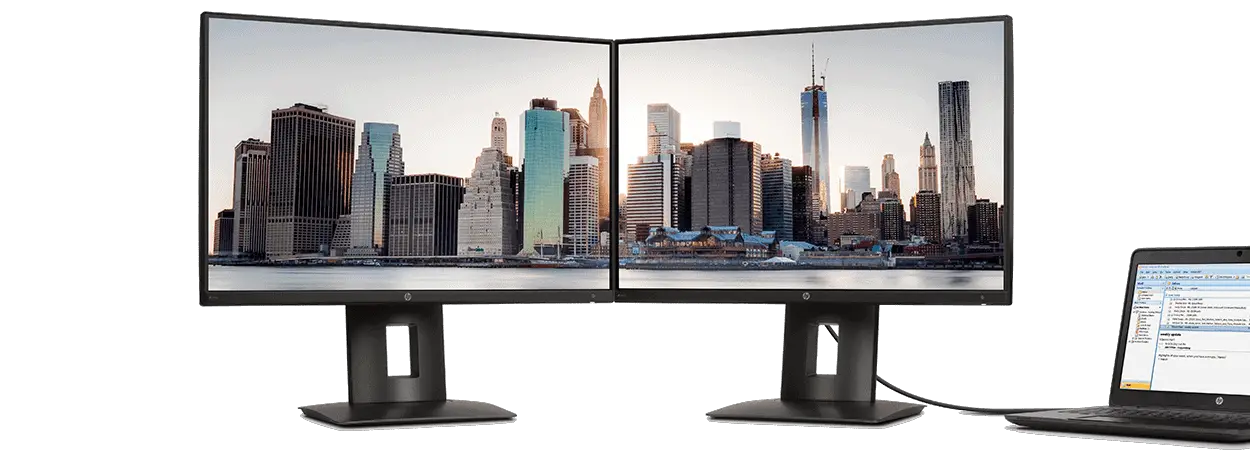Setting up dual monitors with an HDMI port is straightforward. It can open up a new world of efficient multitasking, allowing multiple applications and windows to open simultaneously on two screens. This article will walk you through setting up dual monitors with an HDMI port.
Learn How to Change Mouse Direction on Dual Monitors in our article.

How to Setup Dual Monitors with HDMI?
- Gather all necessary materials, including HDMI cables and two monitors. Ensure that all setup parts are compatible and meet the required technical requirements.
- Connect one end of the HDMI cable to the port of each monitor, then attach the other ends of the two cables to an HDMI splitter.
- Place each monitor in a desired position, ensuring they both face you at a comfortable viewing angle. Consider where natural light will be coming from and adjust positions accordingly.
- Plug both monitors into a power source and turn them on.
- Locate the Input Source button on each monitor and verify it is set to HDMI.
- Check the specs of your computer’s video card computer’s manual to ensure it supports dual displays with HDMI connections. Some graphics cards may require additional software for this feature to work correctly.
- Connect one end of an additional HDMI cable to your computer’s video card output port and the other end to either side of the splitter (HDMI ports are usually labeled as “IN” or “OUT”).
- Open your computer’s”di” play”set” ings menu, tycomputer’sund in Control Panel or System Settings, depending on your operating system. In Windows 10, this can be found under Settings > System > Display or Settings > System > Advanced Display Settings, while in macOS High Sierra, you can go directly to Apple Menu > System Preferences > Displays.
- Select “Identify Displays” (optional) to pr”perly place each “onitor according to orientation/arrangement preferences. Some operating systems may prompt you to do this immediately upon connecting multiple displays through an external connection such as HDMI.
- Choose Multi-Display Mode to set up dual monitors with HDMI: Extend Display or Mirror Display, according to your needs. In Extend Display mode, keep in mind that whatever activity is taking place on one screen will not show up on the other. In contrast, Mirror Display means that whatever appears on one screen also appears identically on the other, providing a similar user experience for both displays simultaneously regardless of what goes on at any given time across them both.
- Adjust each display’s resolution, brightness & display settings to accommodate specific viewing preferences via individual menus provided by each connected monitor.
Please watch an excellent video from YouTube to learn how to set up Dual Monitors:
Additional comments:
Before getting started, you must ensure that you have all the components required for the setup: two compatible monitors that support HDMI input, an HDMI cable, and a computer system with a graphics card or integrated graphics that supports multiple displays. If any of these components are missing, the setup will not succeed.
The first step of setting up dual monitors with an HDMI port is connecting each monitor to your PC using the appropriate cables. For most modern PCs, this means using either DisplayPort or HDMI cables. The cable you need depends on your graphics card/integrated graphics, so double-check what kind of output your system has before purchasing any wires. Once all cables are connected securely, turn both monitors on and wait for them to boot up.
Next, open the display settings in your operating system (typically found in the Control Panel or Settings menu) and select “Extend desktop” from the options gi”en. This will “allow both monitors to act as one extended display instead of two separate displays. You can also use this menu to change the resolution of each monitor separately if desired.
Finally, you must arrange each monitor according to how you want them laid out on your desktop. Depending on what type of system you have (laptop or desktop), this may involve physically moving one or both monitors into position so that they are next to each other at equal distances apart from one. Once everything is arranged correctly, click “Apply” and enjoy your new dual monitor!
Following these simple steps, anyone can quickly and easily get dual monitors set up with an HDMI port without much hassle! Having two separate screens can significantly increase efficiency while working or gaming by allowing different tasks/windows/applications/etc. It is to be opened simultaneously without needing to switch between them manually constantly. Furthermore, connecting multiple devices such as laptops or game consoles through an HDMI connection makes setup even more accessible by eliminating unnecessary hardware like VGA adapters or USB video capture cards!

